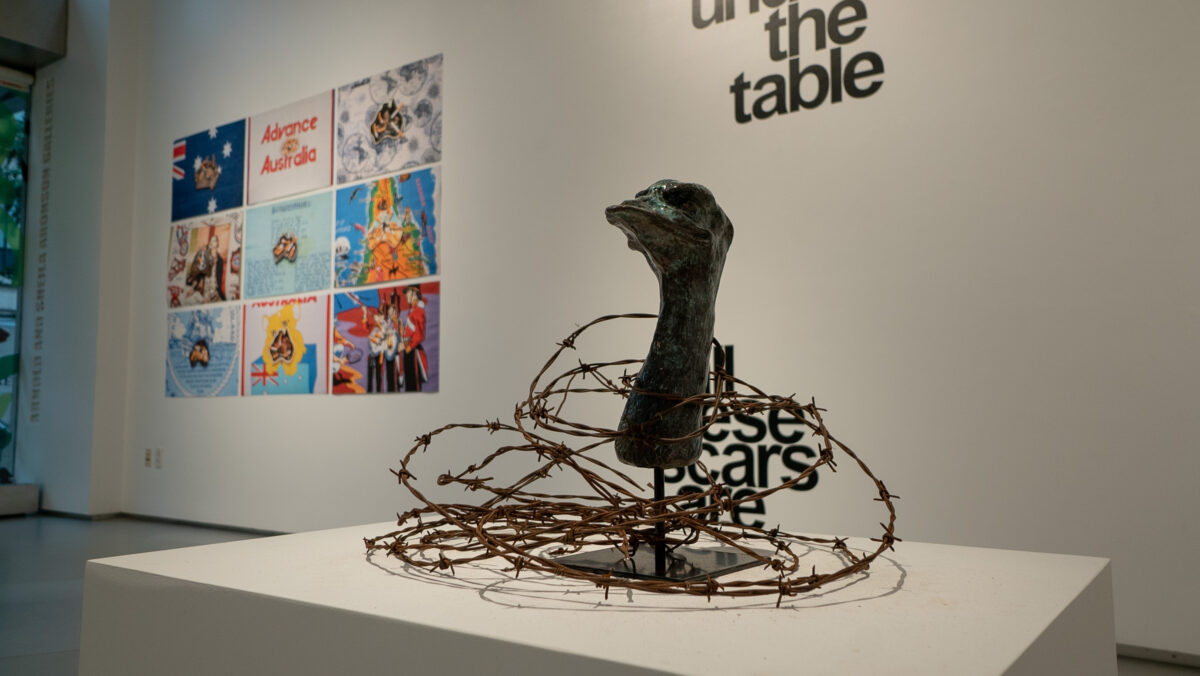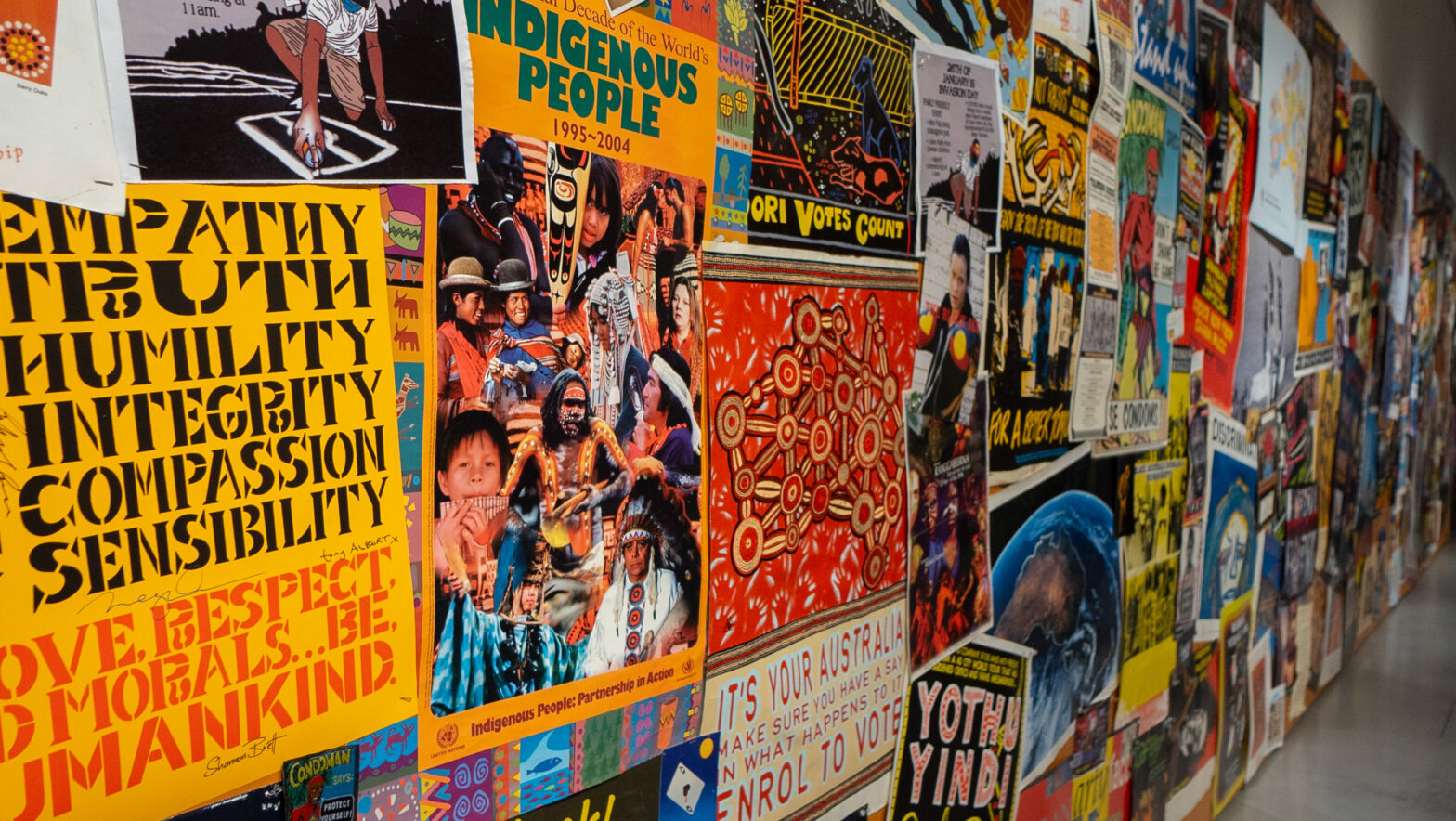This story was updated on Nov. 19 at 5:21pm.
From Oct. 12 through 14, the Vera List Center (VLC) hosted its annual forum culminating with the exhibition opening of proppaNOW: There Goes the Neighbourhood! in the Arnold and Sheila Aronson galleries at Parsons School of Design. The exhibition, which will be on display until Nov. 5, showcases work by proppaNOW, an art collective of aboriginal artists from Queensland, Australia, and this year’s recipient of the VLC’s Jane Lombard Prize for Art and Social Justice. Over the past two years, the VLC worked closely with their Academic Advisory Council to bring an art exhibition to The New School that broadens students’ educational experiences and engages them with the VLC’s focus theme.
The art in the Aronson Gallery is in dialogue with proppaNOW artist Gordon Hookey’s archival poster collection, displayed to resemble wild postings in the hallway outside the gallery. Hookey has been adding to this collection for 40 years, gathering posters related to Aboriginal resistance movements and communities in Australia.
“That hallway is usually such a busy throughway and it’s been amazing to just see people really stop…really try to connect,” Palomino said. “It’s always great to see when things can kind of slow down and people can take a chance to really engage with something.”
“We define ourselves as a forum for public scholarship on the intersection of art and politics,” said Carin Kuoni, the senior director and chief curator of the VLC and an assistant professor of Visual Studies at Parsons. The theme for this biennial cycle of the VLC’s programming is Correction*, which is focused on the social, political, and metaphorical manifestations of Correction, “the act of identifying and rectifying an error or inaccuracy,” through sub-themes of institutional critique, carceral regimes, and the body and self.
“Coming up with the theme is really challenging but also a good opportunity to find all the different threads of what people are thinking about and how we can synthesize [those thoughts], but also inspire a movement forward in something,” said Camila Palomino, a curatorial assistant at the VLC. After a theme is decided, 40 projects by artists all over the world that meaningfully respond to it, are nominated for the Jane Lombard Prize by the VLC’s International Prize Council.

“In between nomination and selection of the recipient, we spend a year trying to learn about the 40 projects that were nominated. We also consult with New School faculty and students and get their feedback on the 40 nominated projects,” said Kuoni. “The reason is that in the end, ultimately the goal is that the prize exhibition and project is a learning opportunity for us at The New School.”
The VLC established their Academic Advisory Council in 2019 to ensure this goal is upheld. The council is made up of faculty and student representatives from all five colleges within TNS. They meet roughly once a month to discuss how VLC programming can work to broaden students’ educational experiences. “It’s a really important entry point into having access to the classrooms and what people are discussing and feeling at the moment,” Palomino said.
The VLC was lucky to have proppaNOW members travel to New York City for the exhibition opening, furthering the connection between the Center and student’s educational experiences. “proppaNOW members have experience with printmaking and wanted to return to working with students, and they had an opportunity to do that here,” Palomino said.

While there is no VLC class students can take, the Center hosts seminars on zoom each month that are available through recordings posted on their website and accompanied by resource guides. “The VLC seminars, in my opinion, work very much like an open campus class, which people can take for free,” Kuoni said.
Cresa Pugh, an assistant professor of Sociology at the New School of Social Research and Eugene Lang College of Liberal Arts on the Academic Advisory Council launched the seminar series for Correction* with her talk, Ashes to Artifact: Cultural Death, Repair, and Restitution of the Benin Bronzes. “You’re supposed to make an intellectual contribution either through a talk or through coursework that aligns with one of these three themes under Correction,” Pugh said of the faculty members’ role on the council.
“I think that the VLC never had a problem with getting people interested in their work. But we want [the exhibition and theme] to be very much embedded in the work that the students and faculty are doing,” Pugh said. This is where student representatives on the council are extremely valuable.
Aisha Servia is served as a student representative on the Council in fall 2023, and is also a leader of a student activist group at TNS. Pugh called Servia “an organizer and an activist. I think it’s good to have students who are on the ground doing this work to then help the faculty make those connections between theory and practices.”
One of the VLC’s goals is to inspire student engagement with the theme of Correction* outside a theoretical framework. One of the ways they achieve this goal is by exhibiting art in proximity to students’ daily routes to class. While the Center is funded by different foundations and individual contributors, the university supports the Center by providing exhibition and office space at no additional cost.
The installation reinforces the Correction* theme as it gives the community an opportunity to engage with creative work that exists on the margins in terms of how the West values art. “It’s correcting this idea that art is only produced by one type of person or institution or group,” said Pugh.
“Different ways of learning, different sources of knowledge, lifelong learning, peer knowledge, and a move away from the academy as an ivory tower to practice-based learning is part of what the VLC continues to do,” Kuoni said.
A previous version of this article did not fully cite the artworks featured in this piece and used inaccurate spelling for the exhibition title. The article has been updated to reflect the correct spelling of “Neighbourhood“ in the exhibition title, and now correctly cites all artworks featured.








Leave a Reply